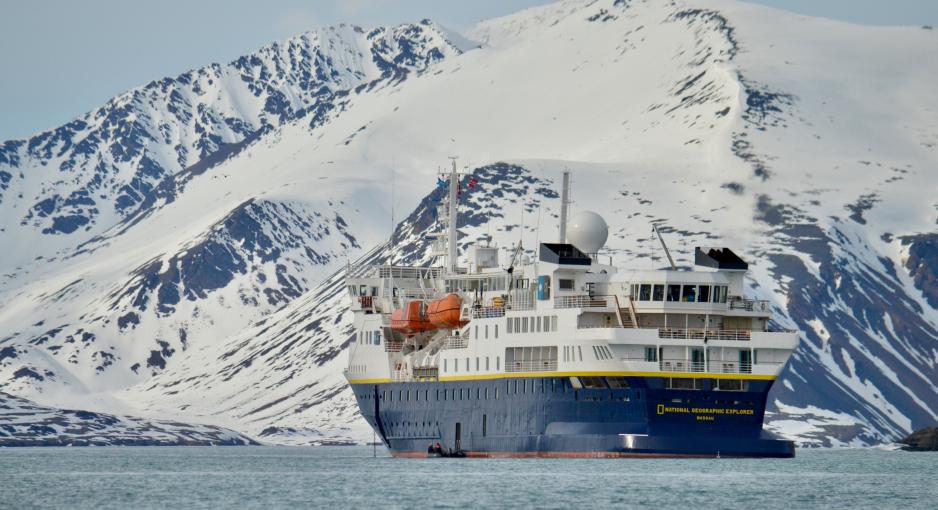New Report on Svalbard’s Tolerance Limit: Sustainable Destination by 2025

Cruise ship National Geographic Explorer off the coast of Svalbard. (Source: Megan Coughlin under CC BY-ND 2.0)
A new report of Svalbard's tolerance limit uncovers knowledge gaps around the cruise industry's emissions. "The government must strengthen its efforts in gathering data on greenhouse gas emissions and the environmental effect of sea-based tourism, a task tourism cannot handle alone," says the leader of Visit Svalbard, Ronny Brunvoll.
The report "Masterplan Destinasjon Svalbard mot 2030" sets the standard for responsible tourism development in Svalbard under the auspices of local actors. It states that cruise-related operations must adhere to the same sustainability targets and principles as land-based tourism.
With this report as their background, Visit Svalbard and the Western Norway Research Institute have developed a tolerance limit analysis for the Arctic island.
The analysis emphasizes that high local value creation and low carbon emissions must determine which ships the tourism destination prioritizes. The national Sustainable Destination scheme also supports the importance of a tolerance limit analysis, which is considered particularly relevant given Svalbard's status as an attractive cruise destination.
The analysis has been prepared with the report as an intended guideline for responsible tourism development in Svalbard under the auspices of local, organized tourism.
Broader approach
However, defining an absolute limit on the number of arrivals and passages in 2024 proved challenging for a complex and composite destination such as Longyearbyen and Svalbard.
"We realized early that Svalbard's complexity made producing a traditional tolerance limit analysis difficult. This is a destination that cannot be defined with two lines under the answer," says Ronny Brunvoll, CEO of Visit Svalbard, in a press release.
We have uncovered several knowledge gaps.
However, Brunvoll is pleased with a broader approach and a knowledge base to guide development and protect the local community, nature, and the industry.
"We have been given a substantial and nuanced recommendation for the way forward, allowing us to navigate the development purposefully. We have uncovered several knowledge gaps and identified where efforts must be reinforced with research and insight," says Brunvoll.
He adds that the knowledge base encourages a local discussion of a tolerance limit, as well as nationally, to ensure local involvement and that the local perspectives and needs are taken care of.
Knowledge gaps on greenhouse gas emissions
Brunvoll says that the report addresses challenging topics and several areas that lack knowledge. In particular, there is little knowledge of how much greenhouse gas emissions the cruise ships are responsible for.
Therefore, the leader of Visit Svalbard calls for the government to strengthen its efforts in gathering data on greenhouse gas emissions and the environmental effects of sea-based tourism, a task he believes the tourism actors cannot handle alone.
"Such data are essential to make knowledge-based decisions and prioritizations in the future," he points out.

CEO of Visit Svalbard, Ronny Brunvoll. (Photo: Line Nagell Ylvisåker)
Specific recommendations
The knowledge base also includes specific recommendations for further development, in which environmental, economic, and social considerations are carefully balanced.
Further improved communication with Longyearbyen's local population on cruise tourism, as well as increased physical facilitation of the central areas, are two of the recommendations.
According to the analysis, these two aspects could contribute to less friction between cruise tourism and the residents.
Ready to use
The research is now distributed to tourism actors, politicians, and authorities and is intended to contribute to informed decision-making processes regarding tourism in Svalbard. Among other things, Visit Svalbard and the Western Norway Research Institute believe the report can be a valuable and updated input for designing a new strategic port plan for Longyearbyen.
The Svalbard Cruise Forum is also conducting a ripple effect and consumption analysis in the summer of 2024, in which the knowledge base is already functioning as supporting material.
In addition, Longyearbyen will be re-branded as a sustainable destination in 2025. This includes an expectation of an upper limit for the number of cruise calls, a task the report has proved particularly challenging.
Also read (Article continues below)
Robust
"To find an upper limit, we must evaluate the capacity of roads and transport infrastructure, toilet facilities, attractions, the number of land-based tourists, the local population's needs, and not least greenhouse gas emissions, among other things. There are several areas to be addressed before anyone can make a well-informed decision here," Brunvoll emphasizes.
According to Ronny Brunvoll, the overall impression is that Svalbard is a robust destination and that the local community tolerates cruise activity.
"I perceive the local population's tolerance limit as good and that there is more irritation on some days rather than a general dissatisfaction. In addition, there seems to be a moral tolerance limit in play since cruise activity also contributes to important local value creation."
Fruitful cooperation
Brunvoll emphasizes that the destination company is continuously working to obtain objective facts, which is essential to the development of any destination.
"The cooperation with the Western Norway Research Institute has been very fruitful; our experience is considered, the researchers are responsive to our knowledge, and it is educational for all involved parties to engage in this type of co-creation," concludes Ronny Brunvoll.
He hopes this will set a standard for how destinations can handle challenges and opportunities regarding tourism in vulnerable environments and serve as inspiration for other destinations.
The analysis was carried out with funding from the Svalbard Environmental Protection Fund.





